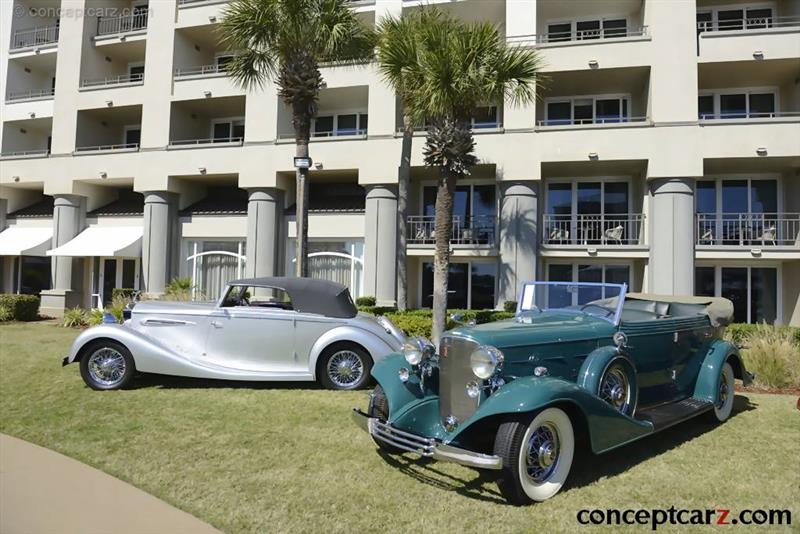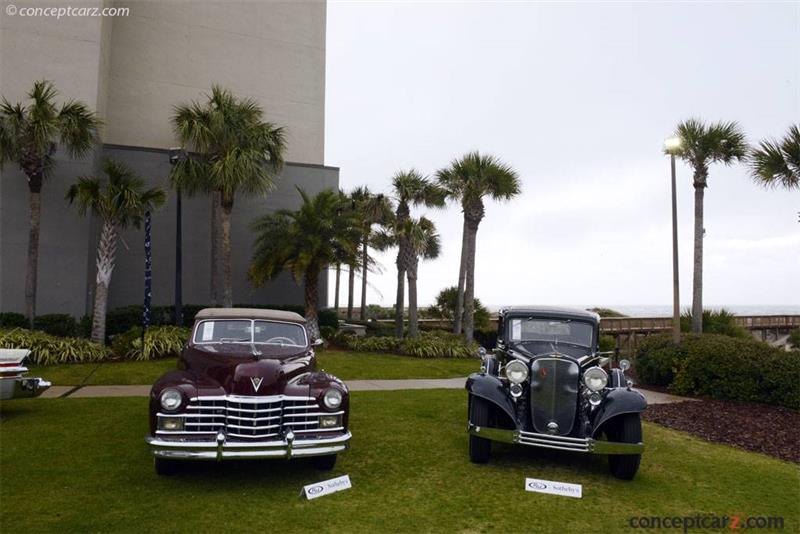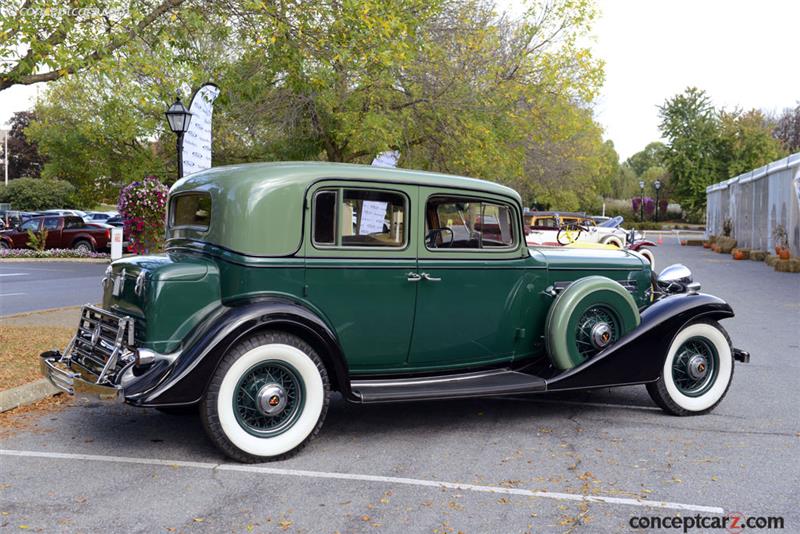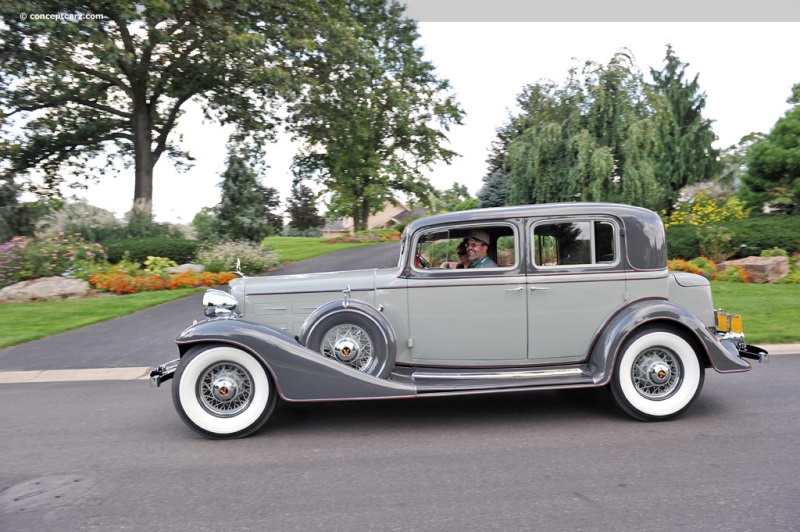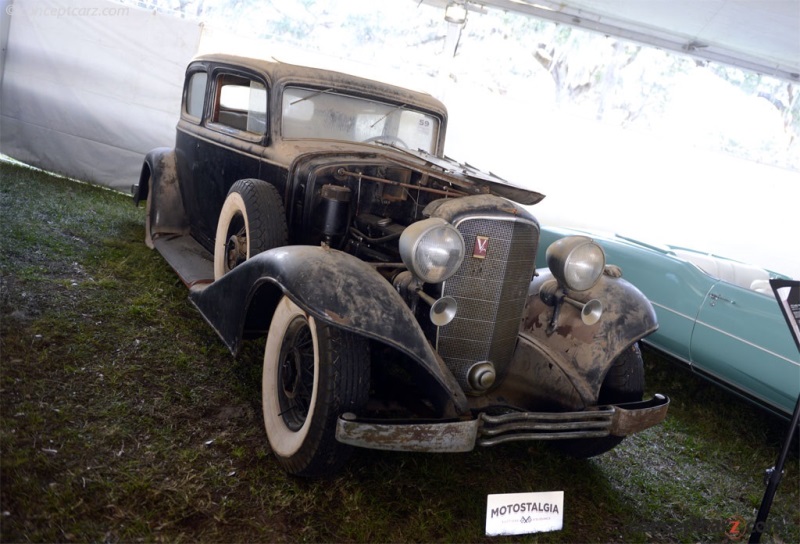The pinnacle of Cadillac's assault on the 'Cylinder Wars' of the 1920s and 1930s was the introduction of the mighty V16 in 1930, its main Achilles Heel being the time at which it was introduced - at the onset of the Great Depression resulting in a lack of sales. A few months later, Cadillac's Chief Engineer Ernest Seaholm and Owen Nacker, announced another new breakthrough, the Model 370 V12 series. It was essentially the same basic engine as the V16, with four fewer cylinders. It was a visual replica of both the V-8 and V-16 Cadillac though no casting was shared, with the most prominent differences being the size, emblems, and the number of ports on the hood side panels. By 1933, V16 production had slowed to only confirmed orders while the V12 was finding some marketing success even though just 1,952 units were produced that year.
Cadillac was not alone in its struggles, as its competitors scrambled to keep up, and for most of these companies, the massive cost of this development effort would combine with a shrinking depression market for luxury cars, creating financial pressures from which the companies would never recover. Pierce-Arrow introduced its V12 in 1932, Marmon began marketing its V-16 in late 1931, and Auburn a V-12 in 1932. Cadillac, with the backing and financial resources of the General Motors Company, wasted no time resting on its laurels and continued to apply crippling pressure with the introduction of the V12 in 1931. Many legendary marques would not live to see the 1940s, including Marmon, Stutz, Pierce-Arrow, and Duesenberg, as they succumbed to the economic pressure. Packard fared better than the other independents by adapting to changing market conditions and lowering their price points with the 110 and 120 Series cars.
Cadillac's V16 engine, introduced in January of 1930 at the National Automobile Show, was the world's first production V16 automobile. Among their features was the highly stylized engine comparts, another industry first, with the motor designed to have nearly no extraneous components, and all of the wiring was nearly completely hidden from view. What greeted onlookers, when the engine bay was revealed, were polished aluminum valve covers, porcelainized manifolds, brushed aluminum ridged surfaces, and the same elegance and attention to detail that could find throughout all other areas of the automobile. It was an engineering tour de force with a 45-degree cylinder bank angle and overhead valve design keeping the engine narrow, while the external manifolding provided easy access. A more efficient overhead valve configuration was provided by the unique hydraulic valve lash compensation system delivering the kind of silent operation normally associated with older side valve engines.
The Cadillac bodies were refined for 1931 with longer, sweeping fenders, lower roof heights, and curved 'coach' sill. The headlights were free-standing devoid of a tie bar, and the radiator was now completely enclosed in a grille shell. The following year, the front-end ensemble received an updated, stylish grille and more bullet-shaped headlights with wind-splits and matching fenders and taillights. The bodies became slightly more rounded and the fenders were a little deeper.
The mechanical changes were few but important, including the addition of vacuum clutches and two-way hydraulic shock absorbers with driver controls. The 368 cubic-inch overhead valve V12 engine with hydraulically silenced solid lifters developed 135 horsepower and was backed by a three-speed synchromesh transmission. There were four-wheel vacuum-assisted mechanical drum brakes, wheelbase sizes of 134- and 140-inches, 17-inch wheel size, and leaf spring and solid axle front suspension system with leaf springs and torque tube drive rear setup.
Enclosed Fisher and Fleetwood body styles created by Harley Earl and his design team had grown in popularity as evidenced by the number of factory-enclosed options that vastly outnumbered open cars. The enclosed cars offered more luxurious appointments, upholstery, and equipment that were impractical on open convertible body styles due to exposure to elements.
1933 was a very difficult year and many consider it to be the worst of the Depression. Although Cadillac brought evolutionary styling and new Fisher No-Draft ventilation which would soon sweep the industry, sales bottomed out. The series 355-C Eight and the Series 370-C Twelve were nearly identical except for the badges and emblems which indicated their engine size. Both shared a 134- and 140-inch wheelbase platform and the factory body style catalogs (sixteen body styles on two wheelbases) were nearly the same with the main differences being the prices. In the front was a vee-shaped grille that blended into the painted radiator shell. A chrome radiator shell was available as optional equipment. The fender tie-bar was now sectioned with the center section hidden from view by its placement behind the grille. The radiator filler cap was also hidden, now located under the hood. The vertical hood doors were replaced by six horizontal doors, and valances were added to the fenders. The rear quarter window and windshield were now stationary, and being devoid of the windshield operating mechanism allowed the closed cars to have the wiper motor concealed behind the headboard.
The front doors received new pivoting vent windows called no-draft Individually Controlled Ventilation (I.C.V). A short time after this feature was introduced, its design was reworked to improve its operation and weather protection. Initially, to pivot the vent window, the door window had to be lowered allowing the channel at its front edge to be disengaged from the vent window. In later production examples, instead of having the sealing channel attached to the window glass, it was attached to the door frame which allowed the vent window to be used independently of the window glass.
Cadillac's assault on the luxury car segment during the 1930s was unrelenting, and its undeniable quality, stylish and modern coachwork, and mechanical innovations kept it as the 'standard of the world.'
by Daniel Vaughan | Jun 2020
Cadillac was not alone in its struggles, as its competitors scrambled to keep up, and for most of these companies, the massive cost of this development effort would combine with a shrinking depression market for luxury cars, creating financial pressures from which the companies would never recover. Pierce-Arrow introduced its V12 in 1932, Marmon began marketing its V-16 in late 1931, and Auburn a V-12 in 1932. Cadillac, with the backing and financial resources of the General Motors Company, wasted no time resting on its laurels and continued to apply crippling pressure with the introduction of the V12 in 1931. Many legendary marques would not live to see the 1940s, including Marmon, Stutz, Pierce-Arrow, and Duesenberg, as they succumbed to the economic pressure. Packard fared better than the other independents by adapting to changing market conditions and lowering their price points with the 110 and 120 Series cars.
Cadillac's V16 engine, introduced in January of 1930 at the National Automobile Show, was the world's first production V16 automobile. Among their features was the highly stylized engine comparts, another industry first, with the motor designed to have nearly no extraneous components, and all of the wiring was nearly completely hidden from view. What greeted onlookers, when the engine bay was revealed, were polished aluminum valve covers, porcelainized manifolds, brushed aluminum ridged surfaces, and the same elegance and attention to detail that could find throughout all other areas of the automobile. It was an engineering tour de force with a 45-degree cylinder bank angle and overhead valve design keeping the engine narrow, while the external manifolding provided easy access. A more efficient overhead valve configuration was provided by the unique hydraulic valve lash compensation system delivering the kind of silent operation normally associated with older side valve engines.
The Cadillac bodies were refined for 1931 with longer, sweeping fenders, lower roof heights, and curved 'coach' sill. The headlights were free-standing devoid of a tie bar, and the radiator was now completely enclosed in a grille shell. The following year, the front-end ensemble received an updated, stylish grille and more bullet-shaped headlights with wind-splits and matching fenders and taillights. The bodies became slightly more rounded and the fenders were a little deeper.
The mechanical changes were few but important, including the addition of vacuum clutches and two-way hydraulic shock absorbers with driver controls. The 368 cubic-inch overhead valve V12 engine with hydraulically silenced solid lifters developed 135 horsepower and was backed by a three-speed synchromesh transmission. There were four-wheel vacuum-assisted mechanical drum brakes, wheelbase sizes of 134- and 140-inches, 17-inch wheel size, and leaf spring and solid axle front suspension system with leaf springs and torque tube drive rear setup.
Enclosed Fisher and Fleetwood body styles created by Harley Earl and his design team had grown in popularity as evidenced by the number of factory-enclosed options that vastly outnumbered open cars. The enclosed cars offered more luxurious appointments, upholstery, and equipment that were impractical on open convertible body styles due to exposure to elements.
1933 was a very difficult year and many consider it to be the worst of the Depression. Although Cadillac brought evolutionary styling and new Fisher No-Draft ventilation which would soon sweep the industry, sales bottomed out. The series 355-C Eight and the Series 370-C Twelve were nearly identical except for the badges and emblems which indicated their engine size. Both shared a 134- and 140-inch wheelbase platform and the factory body style catalogs (sixteen body styles on two wheelbases) were nearly the same with the main differences being the prices. In the front was a vee-shaped grille that blended into the painted radiator shell. A chrome radiator shell was available as optional equipment. The fender tie-bar was now sectioned with the center section hidden from view by its placement behind the grille. The radiator filler cap was also hidden, now located under the hood. The vertical hood doors were replaced by six horizontal doors, and valances were added to the fenders. The rear quarter window and windshield were now stationary, and being devoid of the windshield operating mechanism allowed the closed cars to have the wiper motor concealed behind the headboard.
The front doors received new pivoting vent windows called no-draft Individually Controlled Ventilation (I.C.V). A short time after this feature was introduced, its design was reworked to improve its operation and weather protection. Initially, to pivot the vent window, the door window had to be lowered allowing the channel at its front edge to be disengaged from the vent window. In later production examples, instead of having the sealing channel attached to the window glass, it was attached to the door frame which allowed the vent window to be used independently of the window glass.
Cadillac's assault on the luxury car segment during the 1930s was unrelenting, and its undeniable quality, stylish and modern coachwork, and mechanical innovations kept it as the 'standard of the world.'
by Daniel Vaughan | Jun 2020
Related Reading : Cadillac 370B History
In 1927, the Art and Color department was formed at General Motors with Harley Earl as its leader. For the next fifteen-years, the styling and engineering leadership would keep the Cadillac marque at the top of the fine-car market. Cadillac shocked the world in 1930 with the introduction of its sixteen-cylinder model and sent its competitors scrambling to keep to pace. The hits kept on coming....
Continue Reading >>
Continue Reading >>
Related Reading : Cadillac 370B History
With nearly identical overall styling and appearance to the V-8 except for the emblems, the Cadillac 370B was introduced in 1932. Nearly all of the features were very similar to the 370-A. With an engine that was basically identical, the fuel feed changed to mechanical from vacuum tank. A new Cuno disc type self-cleaning oil filter was also mounted at the right hand side of clutch housing....
Continue Reading >>
Continue Reading >>
Similarly Sized Vehicles
from 1933
Similarly Priced Vehicles
Packard 1005 Twelve ($3,700-$4,700)
Pierce-Arrow Model 1242 Twelve ($3,796-$4,365)
Average Auction Sale: $74,141
Pierce-Arrow Model 1242 Twelve ($3,796-$4,365)
Average Auction Sale: $74,141
Cadillac Monthly Sales Volume
March 2023
36,321
1933 Cadillac Series 370-C Twelve Vehicle Profiles
Recent Vehicle Additions
Performance and Specification Comparison
Price Comparison
$2,700 - $4,145
$6,250 - $8,000
370B Specification Comparison by Year
Year
Production
Wheelbase
Engine
Prices
Related Automotive News

Now Open: 'GM's Marvelous Motorama: Dream Cars From The Joe Bortz Collection'
New exhibition showcases six concept cars from the Joe Bortz collection together for the first time
The Petersen Automotive Museums newest exhibit, GMs Marvelous Motorama Dream Cars from the Joe Bortz Collection, is now open in the Audrey...

ALL-NEW GOLF ALLTRACK AND NEW BEETLE MODELS HEAD THE CHANGES
Volkswagen also simplifies model lineups to put the emphasis on value
Golf Alltrack adds all-wheel-drive ability and rugged off-road looks to the fun-to-drive and practical Golf SportWagen
Golf SportWagen receives 4Motion® all-wheel-dr...

FOUR ENGINES, FOUR DOORS, EIGHT-SPEEDS AND UP TO A WORLD-LEADING 204 MPH: DODGE ANNOUNCES PRICING FOR CHARGER LINEUP
Dodge unleashes the Quickest, Fastest and Most Powerful Sedan in the world, along with the most capable and technologically advanced Charger lineup ever with a starting U.S. Manufacturers Suggested Retail Price (MSRP) of %2427,995
The Dodge and SR...

ALL-NEW 2014 JEEP CHEROKEE TO START AT $22,995
Jeep® raises the bar with legendary benchmark 4x4 capability, world-class on-road dynamics, fuel economy of more than 30 mpg, modern and progressive new design, world-class craftsmanship, and an array of advanced safety and technology features
All-...

BMW at the NAIAS Detroit 2013
Captivating looks laced with premium quality and groundbreaking innovations are the standout features of the models charged with continuing the success of the BMW brand into the future. The NAIAS 2013 in Detroit will see BMW presenting visitors with...



















